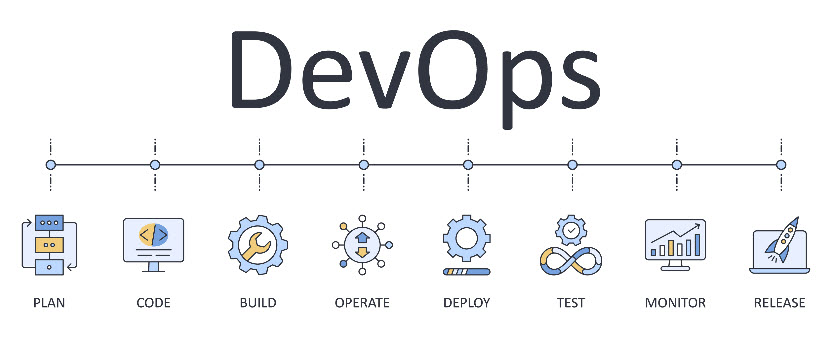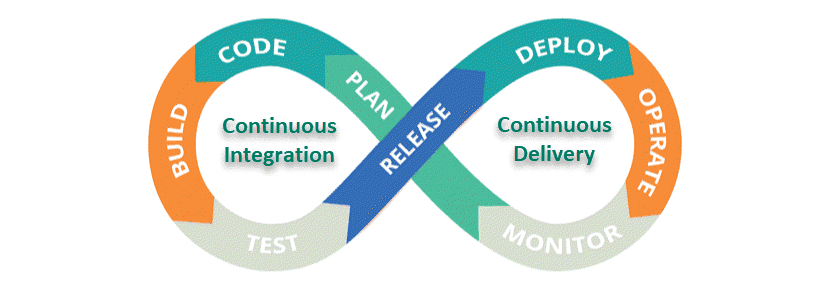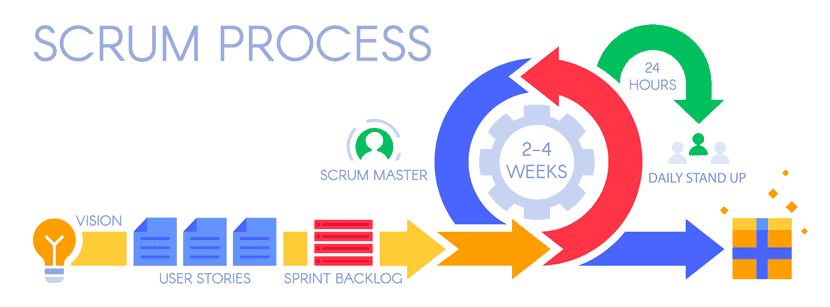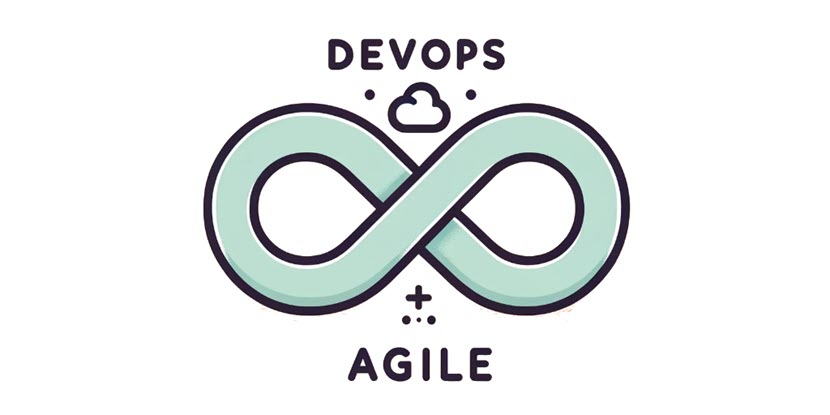DevOps and Agile are approaches that streamline software development and delivery but tackle this challenge differently.
DevOps optimizes the entire software delivery pipeline with automation, collaboration, and continuous improvement. Conversely, Agile prioritizes adaptability and responsiveness to customer feedback by breaking development into iterative cycles with frequent releases.
This article explores the core principles, practices, and critical differences between DevOps and Agile. Understanding their unique strengths and how they interact will help you choose the right approach for your organization's needs.

What Is DevOps?
DevOps is a set of practices that encourage software development (Dev) and IT operations (Ops) to work as a single unit throughout the entire software development lifecycle (SDLC).
DevOps methodology is more than the tools and technologies employed. This approach attempts to merge traditionally siloed teams and foster a culture of communication and shared responsibility so that software is delivered quickly and reliably.
How Does DevOps Work?
DevOps operates through a combination of three key principles.
- Automation. Automating repetitive tasks in coding, testing, deployment, and infrastructure provisioning reduces errors, saves time, and ensures consistency.
- Continuous integration (CI). Developers regularly merge code changes into a central repository, where automated builds and tests identify and address integration errors early.
- Continuous delivery (CD). CD automates application delivery to various environments so that software can be released and deployed quickly.
DevOps thrives on close collaboration and communication between development and operations teams who share responsibility for faster issue resolution. Furthermore, real-time monitoring of application and infrastructure performance facilitates quick problem solving. Feedback from operations to development ensures that insights are seamlessly integrated into the development process, creating a continuous feedback loop.
DevOps Tools
Several tools and practices further streamline DevOps:
- Infrastructure as code (IaC). Managing and provisioning infrastructure through code ensures consistent, reproducible, and scalable environments.
- Version control. Storing code, configuration files, and scripts in a version control system tracks changes, enabling rollbacks and facilitating accountability.
- Security integration (DevSecOps). Integrating cybersecurity best practices from design to deployment ensures a secure development process.
These components support the DevOps methodology and its goals of improving collaboration, speeding up delivery times, and maintaining high quality and security standards in software development.

DevOps Advantages
DevOps replaces siloed teams with cohesive units. This shift unlocks many benefits.
- Enhanced collaboration. DevOps fosters a culture of shared responsibility and continuous feedback between development and operations, breaking down silos and promoting teamwork.
- Automated efficiency. Repetitive tasks are automated, minimizing errors, boosting efficiency, and freeing up team members for strategic tasks.
- Faster time to market. Continuous integration and delivery enable rapid releases of new features and fixes, accelerating time to market.
- Improved quality and reliability. Continuous testing and monitoring ensure high-quality software and a reliable release process.
- Optimized resource management. DevOps practices generate deep insights into resource usage, allowing for optimization and efficiency improvements.
DevOps Disadvantages
The DevOps approach presents several challenges that organizations must address to reap its full benefits.
- Cultural shift. Transitioning to DevOps requires changing established norms across many teams. Employees accustomed to traditional approaches may resist DevOps. Overcoming this resistance requires strong leadership, clear communication, and early and active team involvement in the transition.
- Implementation complexity. Setting up and integrating DevOps tools and processes introduces complexity and impacts the entire software development lifecycle. Furthermore, it requires a deep understanding of the tools and the software delivery pipeline.
- Skillset diversification. Successful DevOps implementation demands a broad skillset, including development, operations, and quality assurance. Upskilling or cross-training teams is essential but may lead to initial slowdowns and increased training costs.
- Resource allocation. Initial DevOps adoption requires a significant investment. Budgets must be allocated for new tools, training programs, and potentially hiring DevOps specialists.
- Security integration. DevOps security presents unique challenges. Balancing security measures with delivery speed and vulnerability protection requires meticulous planning and automated security testing.
phoenixNAP embraced DevOps and never looked back. Read our CEO’s article to find out why we did it, the steps we took, and what we gained.

What Is Agile?
Agile is a project management methodology focused on streamlining software development and delivery. It prioritizes flexibility, customer satisfaction, and high-quality results.
Unlike traditional waterfall methods, Agile embraces iteration with its linear, step-by-step process. This approach enables quick and flexible responses to customer needs or changes in market conditions, making Agile ideal for projects with evolving requirements.
Agile is grounded in four core values outlined in the Agile Manifesto:
- Individuals and interactions over processes and tools. Agile prioritizes teamwork and communication over rigid procedures and technology dependence.
- Working software over comprehensive documentation. Agile focuses on delivering functioning software early and often, valuing practical functionality over excessive documentation.
- Customer collaboration over contract negotiation. Agile fosters close collaboration with customers for their continuous feedback and involvement.
- Responding to change over following a plan. Agile embraces change; plans are adapted as needed rather than rigidly adhered to.
How Does Agile Work?
Agile projects are broken down into small, manageable work units called sprints, typically lasting one to four weeks.
Here are the fundamental practices of the Agile process.
- Sprint planning. This step entails defining the work to be completed during each sprint.
- Daily stand-up meetings. Agile managers organize short daily meetings (around 15 minutes) for team members to discuss progress and challenges.
- Sprint reviews. Managers review completed work and gather stakeholder feedback at the end of each sprint.
- Retrospectives. The final step involves periodically reflecting on sprints, identifying areas for improvement, and planning for future iterations.
Agile Frameworks
Agile frameworks are structured approaches that provide a guideline or methodology for managing and completing software projects by following Agile principles. These frameworks differ in their practices, terminologies, and use cases but share the principles of collaboration, flexibility, and iterative development. Here are the most popular Agile frameworks:
- Scrum. Emphasizes managing tasks within a team-based environment, focusing on delivering complete, functional features within each sprint.
- Kanban. Focuses on a continuous workflow without overburdening the team and uses a visual board to track progress.
- Extreme programming (XP). Aims for continuous improvement and responsiveness to changing needs through frequent releases in short cycles.
Organizations typically choose a framework that best suits their specific project needs, team size, and business environment.

Agile Advantages
The advantages of Agile are deeply connected to its iterative approach to software development and focus on customer collaboration. These benefits include:
- Flexibility and adaptability. Agile allows teams to adapt to changes quickly and efficiently, ensuring the project remains aligned with client needs and market demands.
- Customer satisfaction. Frequent delivery of functional software and the ability to incorporate customer feedback ensures customer satisfaction.
- Improved product quality. Regular reviews and iterations help identify and fix issues early, leading to higher-quality products.
- Better risk management. Breaking the project into smaller segments allows for more effective risk management and mitigation.
Agile Disadvantages
The Agile methodology presents certain drawbacks that organizations need to consider.
- Less predictability. Agile’s flexible and adaptive nature can lead to less predictability in project timelines and budgets.
- Requires significant customer involvement. Agile relies on continuous customer feedback, which can be challenging if the customer is not available or committed.
- Scope creep. Without careful management, the project scope can expand continuously due to its iterative nature and the frequent reassessment of requirements.

DevOps vs. Agile
Below is a comprehensive comparison of DevOps and Agile in table form, highlighting the fundamental differences between these methodologies.
| Agile | DevOps | |
| Definition | Iterative approach focusing on collaboration, feedback, and quick releases. | Unifies development and operations for seamless integration. |
| Objective | Simplify project management, enhance adaptability. | Streamline engineering processes, ensure quick delivery. |
| Change approach | Embraces incremental development (frequent changes). | Continuous testing and delivery for constant improvement. |
| Frameworks | Utilizes Scrum, Kanban, XP, and SAFe. | Collaboration-focused, no set framework. |
| Team dynamics | Versatile skill sets, cross-functional roles. | Specialized skills across development and operations. |
| Team size | Smaller teams. | Larger, inclusive of all stakeholders. |
| Project timeline | Short sprints for rapid deliverables. | Continuous deployment; ideally daily updates. |
| Source of feedback | Direct from customers or end-users. | Internal, focusing on technical, operational aspects. |
| Communication | Daily stand-ups, scrum meetings for alignment. | Detailed specs, documentation for clarity between teams. |
| Documentation | Light, prioritizes working software. | Thorough, essential for smooth operations transition. |
| Automation | Beneficial, not central. | Fundamental for efficiency, reliability. |
| Gap resolution | Closes customer-developer gap. | Bridges development-operations gap. |
| Risk management | Rapid development with risk mitigation. | Ensures changes don't risk project integrity. |
| Tools | JIRA, Bugzilla, Kanboard, Active Collab, Slack, and Trello. | Puppet, Chef, TeamCity. |
How Can DevOps and Agile Work Together?
Combining Agile and DevOps entails integrating the principles and practices of both methodologies. It doesn't necessarily mean an Agile project manager directly oversees a DevOps team. Instead, it involves aligning development, operations, and other teams' objectives and workflows to foster better collaboration, efficiency, and product quality.
Here's a closer look at the practical implications of this integration.
Roles and Responsibilities
In an environment where Agile and DevOps work together, the traditional boundaries between roles become more fluid.
While an Agile project manager focuses on ensuring the development team adheres to Agile principles (like sprints, scrum meetings, and rapid iterations), the integration with DevOps principles requires them also to consider:
- Continuous integration/continuous delivery (CI/CD) pipelines.
- Infrastructure automation.
- The transition from development to deployment.
Read our article on DevOps roles and responsibilities to learn who you need to hire and what you need to account for to create an efficient DevOps team.
Collaboration and Communication
Implementing DevOps and Agile encourages constant communication and collaboration within the development and operations teams and other stakeholders.
The goal is to create a culture where everyone knows the project's status, challenges, and goals at every lifecycle stage. This awareness doesn't mean an Agile project manager directly oversees operations tasks but works closely with those who do to ensure that development and operations efforts are aligned.
Practical Implementation
A combined Agile and DevOps approach might include:
- Integrated planning. Development and operations staff collaborate from the start, preemptively addressing potential deployment and operational issues.
- Shared tools. Utilizing common platforms for version control, CI/CD, and monitoring smoothens the transition from development to deployment.
- Skill expansion. Team members broaden their expertise, with developers learning about operations and vice versa, enhancing team flexibility and efficiency.
Example: A Unified Approach in Action
Imagine a software development project aimed at delivering a new online shopping platform. The Agile project manager schedules sprints to deliver features like product listing, shopping cart, and payment gateway integration. Meanwhile, DevOps practices ensure that as these features are developed, they are continuously integrated and tested, with changes being deployed to a staging environment for real-world testing.
As feedback is gathered from stakeholders and real users, it is fed into the development process, allowing the team to adjust. The operations team, working closely with developers, ensures the production environment is ready to scale and perform as user load increases, using infrastructure as code to automate environment setups and deployments.
The example above illustrates how merging Agile and DevOps can lead to a scenario where software is developed flexibly and iteratively while being continuously integrated, tested, and deployed.
Tired of the constraints and overhead of virtualized cloud environments?
Our Bare Metal Cloud delivers the raw power and control you need.
phoenixNAP’s Bare Metal Cloud includes:
• Instant provisioning capabilities that allow you to spin up dedicated servers in minutes.
• Predictable performance with no noisy neighbors and consistent power for your demanding workloads.
• Global reach with multiple data center locations for optimal speed and availability.
Simplify infrastructure management and accelerate your DevOps workflows with phoenixNAP Bare Metal Cloud!
The Synergy of Agile and DevOps
Combining Agile and DevOps creates a synergy that goes beyond each methodology's individual capabilities. This powerful duo fosters a culture of shared responsibility and open communication, where everyone involved feels ownership of the development process.
Furthermore, integrating DevOps automation into Agile cycles streamlines testing and deployment. Reducing manual tasks and optimizing workflows enables software to move from development to deployment faster, maintaining high quality while reducing time to market.
Another key benefit is the continuous feedback loop, which combines Agile's focus on user input with DevOps' emphasis on operational data. This loop ensures that the development process is closely aligned with user needs and technical realities.
However, effective leadership is vital in unlocking the full potential of Agile and DevOps. By nurturing this environment, managers empower their teams to create a dynamic and responsive development ecosystem capable of delivering high-performance software.



